Robot Framework框架简介
- Robot Framework框架是一个通用的验收测试和验收测试驱动开发的自动化测试框架(ATDD),使用的是关键字驱动的测试方法。它本身拥有强大的标准库,此外还可以根据项目需要,使用Python对其测试库和框架本身进行扩展和优化,能同时满足对接口、数据库、UI自动化和服务器端自动化的测试需求,编写测试用例的成本低,维护方便。
项目说明
- 本框架使用的是接口设计的分层玩法,分层的原则是:接口数据和接口业务分离。具体为:项目目录结构分层,接口数据与接口用例分离,接口用例与接口业务分离,公共方法和公共配置也接口业务分离,在测试用例中可以传入不定参数,同时也可以定义用例的执行顺序。
技术栈
- Robot Framework
- RequestsLibrary
- HttpLibrary.HTTP
框架目录结构及相关说明
1、框架目录结构图如下
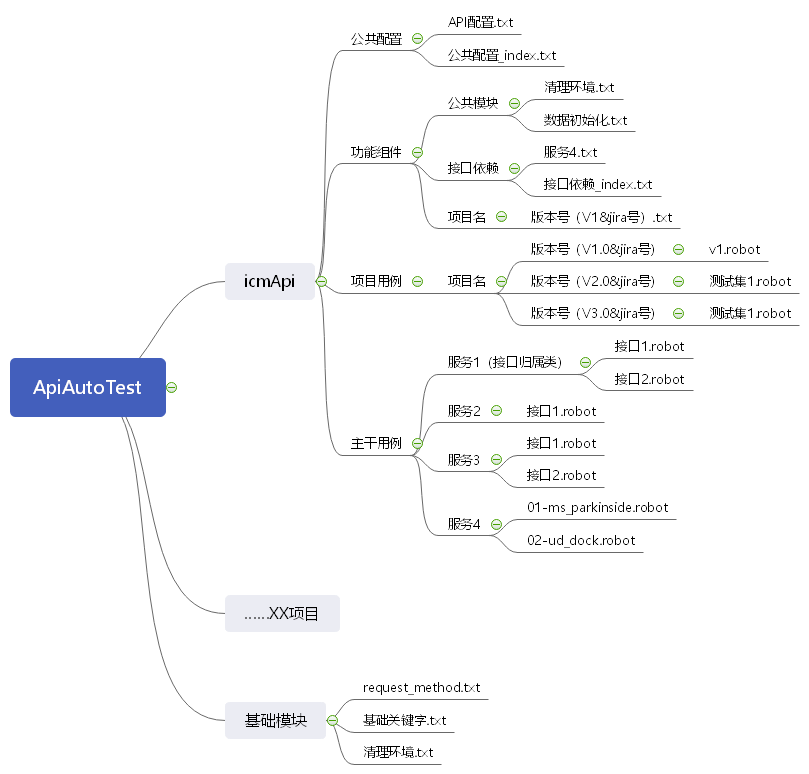
2、目录结构说明
- 公共配置 ===========> 配置文件,定义公共请求头、请求域名等
- 基础模块 ===========> 封装请求方法,公共方法和工具方法模块
- 功能组件 ===========> 封装接口业务模块,接口依赖模块,多个接口组合复杂业务场景等
- 主干用例&项目用例 ===========> 存放接口测试用例
代码设计与功能说明
1、封装请求方法,如下
*** Settings ***
Library RequestsLibrary
Library Collections
Library HttpLibrary.HTTP
Resource ../icmcenterApi/公共配置/公共配置_index.txt
*** Keywords ***
SendPost
[Arguments] ${root_url} ${uri} ${ParameterDict} ${DataType} ${header}
[Documentation] ${root_url}:接口的host;
... ${uri}:接口uri;
... ${dict}:接口传入参数,字典数据类型;
... ${DataType}:传入参数类型,如data等;
... ${header}:请求头,字典类型。
...
... 响应数据为json类型。
...
... 若为独立请求,可在请求结束后立即释放连接。
${RequestData} Create Dictionary
log ${ParameterDict.keys()}
: FOR ${key} IN @{ParameterDict.keys()}
\ set to dictionary ${RequestData} ${key} ${ParameterDict['${key}']}
log ${RequestData}
create session api ${root_url}
${response} post request api ${uri} ${DataType}=${RequestData} headers=${header} timeout=${timeout}
# 将json的string类型的数据转成python的字典类型
Comment ${ResponseBody} To Json ${response.content}
sleep ${sleepTime}
log ${response.text}
[Return] ${response.text}
SendGet
[Arguments] ${root_url} ${uri} ${ParameterDict} ${header}
[Documentation] 响应数据为json类型
${RequestData} Create Dictionary
log ${ParameterDict.keys()}
: FOR ${key} IN @{ParameterDict.keys()}
\ set to dictionary ${RequestData} ${key} ${ParameterDict['${key}']}
log ${RequestData}
create session api ${root_url}
${response} get request api ${uri} params=${RequestData} headers=${header} timeout=${timeout}
Comment ${ResponseBody} To Json ${response.content}
sleep ${sleepTime}
log ${response.text}
[Return] ${response.text}
re_session
[Arguments] ${host}
[Documentation] 创建会话
create session session ${host}
re_post
[Arguments] ${uri} ${ParameterDict} ${DataType} ${header}
[Documentation] 不创建会话,仅发送post请求;
... 响应数据为json类型
${RequestData} Create Dictionary
log ${ParameterDict.keys()}
: FOR ${key} IN @{ParameterDict.keys()}
\ set to dictionary ${RequestData} ${key} ${ParameterDict['${key}']}
log ${RequestData}
${response} post request session ${uri} ${DataType}=${RequestData} headers=${header} timeout=${timeout}
Comment ${ResponseBody} To Json ${response.content}
sleep ${sleepTime}
log ${response.text}
[Return] ${response}
re_get
[Arguments] ${uri} ${ParameterDict} ${header}
[Documentation] 不创建会话,仅发送get请求;
... 响应数据为json类型
${RequestData} Create Dictionary
log ${ParameterDict.keys()}
: FOR ${key} IN @{ParameterDict.keys()}
\ set to dictionary ${RequestData} ${key} ${ParameterDict['${key}']}
log ${RequestData}
${response} get request session ${uri} params=${RequestData} headers=${header} timeout=${timeout}
Comment ${ResponseBody} To Json ${response.content}
sleep ${sleepTime}
log ${response.text}
[Return] ${response}
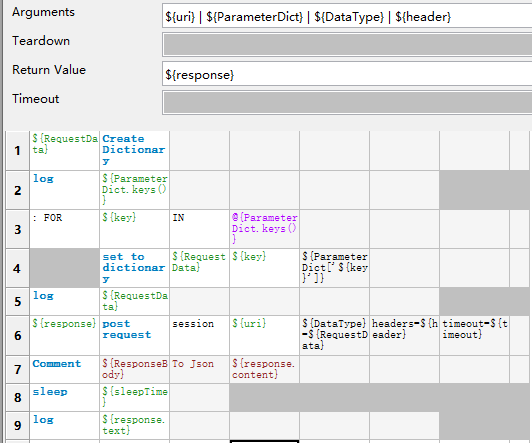
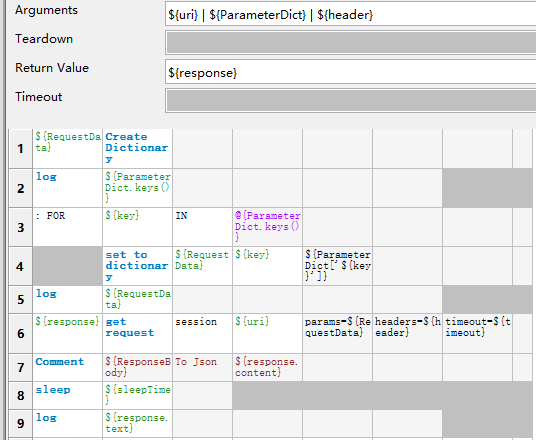
- 以不定参数的形式封装请求,后续调用时,可传入不同个数的参数,方便不同场景下测试用例的设计
2、封装接口业务模块
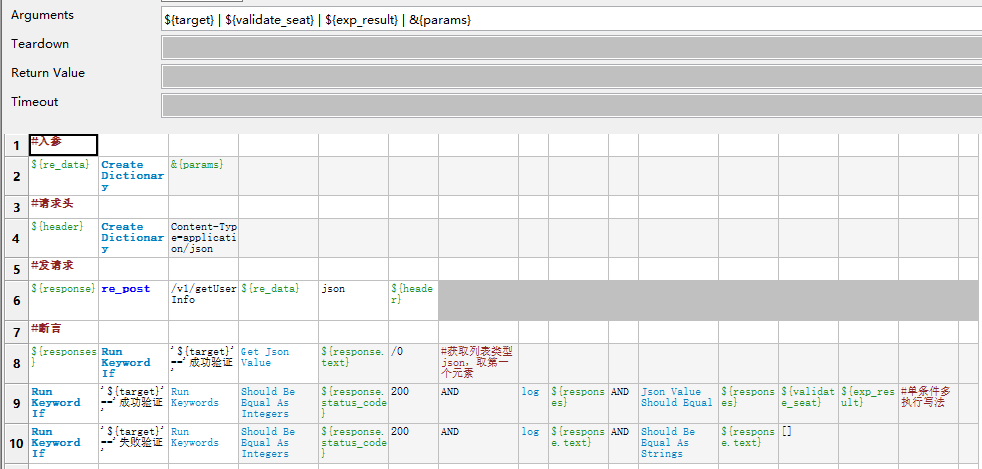
- 根据业务应用场景,组合接口模块
- 发起请求,获取响应,并进行响应断言
3、测试用例设计
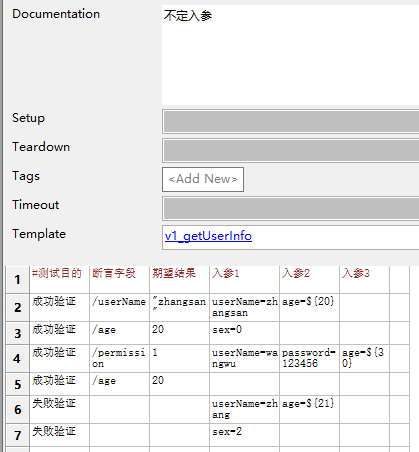
- 根据业务场景,设计测试用例
- 调用组合的接口模块,并依据场景需要,传入不同的参数
项目实例演示










